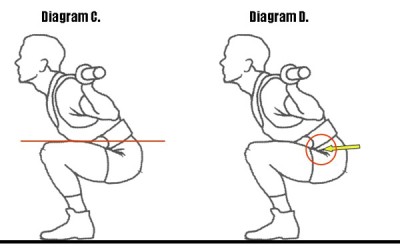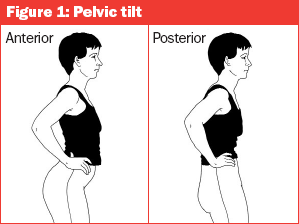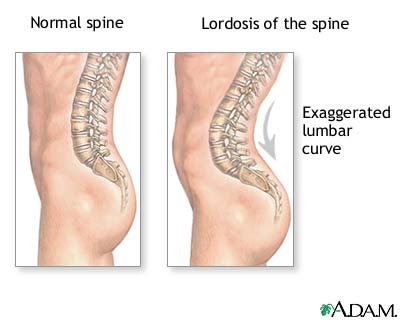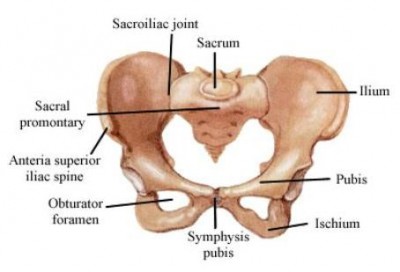PR Friday is a time to rejoice in any personal records you hit in the past week, update everyone on your training, and ask random training questions. Chances are other readers can help, and if not I’ll provide my own opinion. Good day to you, sir/madame.
I’ll add stuff to this throughout Friday, but the following video has nothing to do with 70’s Big.
Update: I said I was gonna add some stuff, but I’ve got nothin’. I’ve been doing this for over a year every week day, and unless I write an in depth post, I’ve got nothin’.
The Butt Wink
Awesome quote:
Evan: Do you cycle (insinuating road biking)?
Dr. Metzler: Periodically.
Periodically I get questions on whether or not the “butt wink” is an issue. The first thought that comes to mind is “who the hell thought of the term ‘butt wink’?” Winking requires the closing of an orifice, and everybody knows that in order to close your outer sphincter, you have to clench your butt cheeks together. You can’t do this while squatting, and if you do, you’re doing a half squat. So stop, god dammit.
Editor’s Note: Yes, there’s more than one sphincter. What?
2nd Editor’s Note: I don’t recommend Google image searching “butt wink” with the safe search “off”.
The butt wink is a made up term to refer to the alleged posterior tilt of the pelvis at the bottom of a squat. Posteriorly tilting the pelvis is the same motion you’d make if you wanted to hit your pubic bone against a wall (guys will probably crush their junk in the process). It’s important to note that observed butt winks are McCarthy’d when a person is doing a body weight squat (i.e. without a barbell). During a body weight squat, the trainee is told to keep their back in hardcore extension to avoid the wink. There are a few trainees that need this kind of cuing to achieve a proper spinal alignment, and those who don’t get in the habit of over-extending their thoracic and lumbar spine. The body weight (BW) squat is commonly (and incorrectly) taught as a precursor to a barbell squat, and the progression is misleading since they teach incorrect extension and mechanics during a barbell squat.
The BW squat is an incorrect first step because of the means and the end. The mechanics of it are unimportant since it isn’t loaded with additional weight and the squat itself is routinely executed safely after dropping a deuce everyday (two or three times if you’re me — yeah c’mon). It is also used as a conditioning tool — NOT a strength builder. Trying to claim that the BW squat will build strength is like saying non-alcoholic beer gets you drunk. Floozy.
Every person’s body dimensions will not be able to fit the mold of an “upright torso” anyway. A person with long femurs and a short torso must lean over when squatting all the way down in order to manipulate their body to have a stable center of mass (unless they are wearing Lady Gaga’s heels). Furthermore, some trainees won’t have the flexibility to get to the proper depth in a BW squat. If the same trainee places a barbell on their back, it provides a little more external resistance that helps push them down into proper depth. This is similar to PNF (proprioceptive neuromuscular facilitation) stretching; elongating a muscle as it attempts to provide a resistance to the stretch. A trainee in this situation is not using enough weight to cause harm (anywhere between 45 and 95 lbs), and in fact the weight is helping them achieve proper depth, let their muscles stretch, and working all of the muscles around the knees and hip through a full range of motion. A coach who has their thumbs anywhere but in their ass can easily teach this correctly.
The above addresses the lack of logic in battling against a “butt wink” in a BW squat and dealing with an inflexible trainee, but what about the wink itself? Does it happen under a load? If it does, should we all be concerned? Frankly, I’ve never had a situation where there’s a “butt wink” worth worrying about. Lifters should be taught to shove their knees out when squatting, whether they are doing high bar, low bar, or front and overhead squats. Shoving the knees out avoids any impingement, bony or soft tissue, and is explained in detail by Mark Rippetoe in several sources. Not shoving the knees out is probably the culprit for most “butt winking”, so the point is almost moot.
Let’s say there is a little “winking” (I keep putting it in quotes because the term is fucking ridiculous) going on when barbell squatting. It’s unlikely that it’s caused by tight hamstrings since those hamstrings are allowing a full depth squat (with knees out). There are two reasons I’ve thought of for this happening. The first is related to the “over extended back thing” that is taught in the BW squat. If a trainee over extends their back under a load, the spinal column is now in an inefficient position to transfer force. There are two points where problems typically occur: where the thoracic spine meets the lumbar spine, and where the lumbar spine meets the sacrum. If either area is “over extended” tremendous forces are no longer passing through them to the pelvis (and subsequently legs) and instead are pinching the posterior and opening the anterior portions of vertebral segments. Not good.
Don’t think it can happen? Well it does. Aside from hearing about it regularly, a 70’s Big reader recently wrote in and told me they herniated a disc because they were trying to over-correct the horrid “butt wink”. That’s a damn shame. You need your trunk to be straight when lifting so that your spine doesn’t look like a parabola (one that has the y coordinate squared). A coach with clean thumbs can take care of this.
Let’s say that a trainee is taught to over-extend their back on a BW squat, and then does the same thing on light barbell squats. The weight won’t be significant enough to hurt them (and it shouldn’t when teaching squat technique), but their pelvis will naturally pull out of this over-extension at the bottom of the squat. This will appear to be flexion, and it is because the pelvis posteriorly tilts to go back into a neutral alignment because it was extended too far to begin with. A shitty coach says, “Flexion! You are banished from the bar to only perform ‘air squats’ until you get it right!”, but it’s their own fault for teaching the asinine over-extension position. This issue constitutes nearly ALL of the “butt wink” cases that occur when the trainee is correctly shoving their knees out (if they aren’t shoving the knees out, then the aforementioned hip impingement will create the wink).
The other cause for a “but wink” could be anatomical. In coaching it is extremely important to identify different body dimensions and how they affect mechanics. After observing many limbs and trunks, I started noticing differences in pelvis length. The pelvis itself starts at the sacrum (below the last lumbar vertebrae), wraps around your sides in the form of the iliac crest, and then the pubis closes in from each side on the front of your body at a connection called the pubic symphysis. Usually pelvis variations aren’t a big deal, but if a person has a very long pelvis it alters how they look when squatting or deadlifting. Their low back never looks like it’s extended and can even look like it is lumped out, appearing to be in flexion. Instead, their pelvis may be long enough such that it doesn’t produce a fancy lordotic curve when in position (particularly the bottom of a squat and the start of a deadlift). I’m not saying this is the case all of the time, but it is definitely a possibility; it isn’t crazy to assume pelvises come in varying lengths/widths while we commonly accept that spinal columns, femurs, tibias, humeri, and radii/ulnas all vary in size and shape.
While I’ve noticed varying pelvis lengths in adults, it’s more noticeable in children and adolescents. I haven’t studied a whole lot on bone development, but this age group seems to grow femurs and pelvises before spinal columns. Looking back, the majority of kids I’ve coached are included in this anatomical observation. A trainee with a long pelvis will probably look like they are doing something wrong, but may just look funny because of their anatomy. This structural issue may be what is causing the dirty thumbed coach to shout “butt wink”.
Hopefully after learning some of the anatomy and conceptual lessons here you have a better understanding of why the “butt wink” is horse shit. In general, trainees should shove their knees out when squatting and this will allow proper depth. If a “wink” is occurring in a BW squat, it doesn’t fucking matter because it’s a Body. Weight. Squat. It’s used for conditioning and deuce dropping. When someone McCarthies a “butt wink” on a weighted squat and the trainee is shoving their knees out, that person is either a shitty coach, a pervert, or flamboyant because they are clearly staring at the lifter’s ass. Properly coached squats don’t really have “butt winks”, and if they do, I think it can be explained by their anatomy (and they aren’t a big deal anyway).
Squat All of the Way Down
I’ve mentioned before that I’ve been exposed to a regular fitness facility for the first time in a while. People with good intentions wander around the room ready to implement either what they have read in mainstream magazines/websites, or what convoluted knowledge they’ve picked up over the years. It’s a shame that they have been misled by people who know better, but I guess it could be worse; they could be sitting at home. In any case, there are still some things that I see that make my eyes bleed. Alas! This is an unfortunate reality for many readers of this site. Hopefully my observations can prevent any readers from following suit.
In most facilities it’s rare to see someone squatting with a barbell. Hell, it’s rare to have more than one rack to do it in. It’s even more rare to see someone doing anything lower than a half squat…and this saddens me. Skinny guys weighing less than 160 pounds and wearing fingerless gloves load the bar to 185 or 225 (apparently it’s sacrilege to use the smaller plates) and bust out some hard fought half rep squats. These guys don’t have any business loading this kind of weight, and if they did an honest-to-god full squat, they would squat significantly less than my girlfriend. I’ve seen another guy who actually had some squatting experience put 405 on the bar (after I did) and squat it below the halfway point, albeit five inches high.
If you can’t or don’t squat ALL of the way down, you don’t have any business squatting. I will personally kick the ass of any reader of this site who does a half squat. If there’s any doubt to the depth of your squat, then it was high. Yes, I’ve cut some reps off before (most people have), but making it a habit is unacceptable. Aside from looking like a complete poon, you’re wasting your time because you aren’t getting much benefit from half squats.
The “low bar” squat (as indicated in “Starting Strength”) necessitates proper depth. Growing up, proper depth was always considered to be at parallel (even though parallel isn’t clearly defined), but it should be thought of as the point where the hip joint is below the knee joint. Visually, that would be a point where the crease flexed hip is below the top of the knee (note: this gets harder to see when the lifter has more girth).

Lowering the hips below the knees does a few things. Specifically for the “low bar” squat, it ensures there is enough depth for the adductors and hamstrings to stretch so that they can subsequently contract with the aid of the “stretch shortening cycle“. Taking advantage of this “bounce” is vital for a strength trainee. If the depth is cut short, then the bounce isn’t possible because the related muscles aren’t stretched adequately prior to their contraction. Visually it will look like a slower rep than if the bounce occurred.
Squats at proper depth also train all of the musculature around the knees and hips through a full range of motion. There is no utility in training half of a muscle’s range of motion. Half squats at the high or low bar position handicap the lifter and severely limit their strength progression. They also make the lifter look like a fucking Nancy. If you’re gonna spend time lifting, you my as well do it right. If that means reducing the weight by as much as 50 to 100 pounds, then so be it. It is what it is.
And I don’t want to hear any shit about people doing half squats to make their lifts go up. 99% of people on this site don’t have any business dicking around with half movements anyway. Unless you’re Mike Tuchscherer, eating and squatting all the way down should be your only concern. Every time you don’t squat to depth, I pour a beer down the drain. And I HATE wasting beer.
Chris hits solid depth on this 585 double:
COW – 4 Oct to 8 Oct
From the PR Friday post — this made me laugh.
Obeast Says:
October 8th, 2010 at 8:02 pm eI think Chris discovered the only way to make white gym shorts not look gay. You have to pull 600 for a triple while wearing them.
Score:
1 – Jacob
1 – StonewallWells
1 – tonypop
1 – High Voltage
1 – MKingW
1 – Obeast
Here is a classic vid of Brent AKA Shrug Thug AKA The Asian Persuasion AKA The Biggest Fucking Troll I’ve Ever Met AKA The Stereotypical Asian Techno Guy AKA I’m Going To Kill Brent In Cold Blood AKA That Was A Joke…Sort Of AKA Brent Hasn’t Gotten Starcraft Yet
PR Friday
I don’t know where Justin is, but it’s probably PR Friday there, too. Weights lifted, ales hoisted, and Yankee fans nut-kicked.
Two items of interest.
1. This is 15 minutes from me.
2. In case you haven’t seen it, this is how you keep it real on the C2:
—–
Justin: I was working on other stuff on Friday morning and didn’t realize Gant published this post. For those of you that commented on the post I put up, hopefully you’ll re-comment. I’ll copy/paste a few of the posts. Here’s a vid of Chris squatting 585×2 at a globo.
Chris pulling 600×3:




